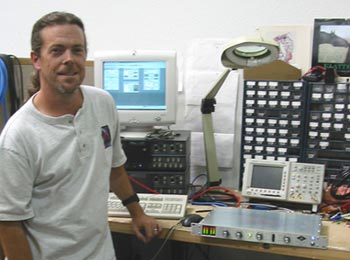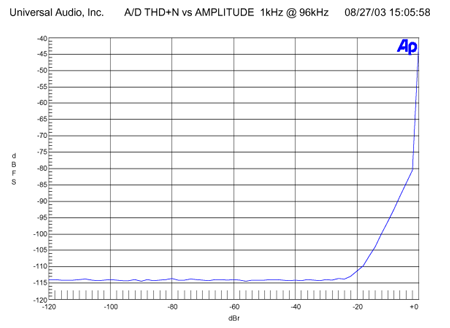Ask Joe! VP of Engineering Joe Bryan Answers Many Questions About the 2192
 |
|
|
Q: “What approch did you take designing the 2192, i.e. what were the engineering goals?”
A: The 2192 Master Digital Audio Interface was designed with two primary goals: First, above everything else, it had to sound absolutely great, and second, it had to be really easy to use.
The 2192 we've built is very different from the one we started out to build. We went through a complete design cycle starting about a year and a half ago, but we weren't happy with the results, so we started over from scratch. We'd built a great converter based on the best components available, but during extensive listening tests to select the op-amps we wanted to use, we quickly realized that all the venerated high-quality IC op-amps available were simply not good enough. Even after playing some tricks to make them sound as good as possible (biasing them class-A to eliminate crossover distortion, etc.), we couldn't get them to sound the way we wanted, so we decided to design our own op-amps that met our sonic requirements without compromise.
Q: “How does the 2192 compare on paper to other 'standard' converters”
A: Specifications are misleading because they don't tell the whole story. Something can look great on paper, but still sound bland. Many specifications are useful, but we haven't found one yet that describes the sonic qualities that separate something that's good sounding from something that's great sounding. Phase and frequency response, distortion, dynamic range and linearity are important indicators, but they're based on sine wave signals that no one listens to! Transient response in a complex, dynamic music signal is very difficult to measure because the simplistic measurement tools we have are very primitive compared to the human hearing system. Also, the behavior of a complex musical signal in a real circuit is very different from the theoretical behavior of an idealized model. This is something we've been studying extensively while designing both analog circuits and DSP systems that model them.
Q: “Your ad for 2192 says 'Class-A, Discrete, DC Coupled'. why did you go to this additional expense when many respected designs use IC chips?”
One of the biggest problems with IC op-amps in audio applications is their high open loop gain. This means you have to wrap a lot of negative feedback around them to use them at the low gains required by an analog converter. The problem with high loop gain is that errors caused by transients, overshoot, intermodulate distortion, etc. are big and must be corrected for by huge amounts of negative feedback. However the intermediate circuit elements within the op-amp don't get corrected immediately because these devices don't have the required infinite frequency response assumed by the classical circuit models. To make matters worse, high loop gain requires more circuit elements to provide the added gain needed for the "corrective" negative feedback, which exacerbates the problem. It's like throwing gasoline on a fire to put it out.
Our class-A, all discrete op-amp design approach was to use low-gain op-amps with matched, high precision components, and minimal component stages in order to reduce the errors in the first place. We use only enough negative feedback as we need to provide stability, low output impedance, and good linearity.
Q: “What's so great about DC-coupling?”
A very significant aspect of coupling capacitors, otherwise known as DC-blocking caps, is their low-frequency phase response. All coupling capacitors are high-pass filters, which means they introduce low-end phase distortion. Unfortunately, phase distortion is most apparent at low frequencies, and it severely affects transient response and imaging. When the beater of the kick drum hits the head, the signal spikes rapidly because there is more information in that signal than most musical signals. Any smearing of that transient is heard as a lack of presence and detail, and a general "it's not quite there" effect.
Since a 24-bit converter has a theoretical dynamic range of about -145dB, circuit noise becomes a significant issue. With a maximum output level of +22dBu, this means the circuit noise cannot exceed -123dBu or about 0.5 mV. At these low levels, thermal noise becomes a dominant factor, so circuit impedances must be reduced as much as possible. This causes a problem with capacitor coupled circuits because as the resistance is lowered, the capacitors must get bigger. Capacitors have a critical influence on sound quality, and big capacitors that sound good are very expensive. We decided to completely eliminate all coupling capacitors in order to realize the lowest possible circuit impedances and thus the lowest noise floor.
Another major factor that affects dynamic range is noise immunity. Any analog circuit that requires a low noise floor must be designed as a differential circuit so common mode noise is eliminated. We designed the 2192 to use not just fully-differential analog circuitry, but dual-differential circuitry. This means we use *two* fully-differential circuits for each signal.
Q: “How is the low end when sampling at 192 kHz”
One of the biggest criticisms of many high-sampling rate converters is the "spectrum shift" that happens as the sampling rate is increased. We heard this with many of the converters we listened to, and it sounds like you're viewing your signal through a fixed window that slides up and down the spectrum: Either you get to hear tight bass, or good highs, but not both at once. We determined that this was caused by the phase distortion in the analog high-pass and digital filters used by these converters. Our solution was to eliminate all DC blocking capacitors, all DC-servo circuits (which are a type of high-pass filter), and use a digital offset calibration scheme that maintains maximum headroom without capacitors or sample rate dependent digital high-pass filters.
Q: “Does the 2192 have soft clip or limiting?”
We designed the 2192 to be both as accurate as possible, and as musical as possible. These are conflicting goals at high signal levels because transients can easily overload even a "perfect" converter. This is simply because digital signals don't have infinite headroom. This isn't as much of a problem in analog circuits because analog clipping introduces harmonics that are usually musically related to the signal. Digital is different. Because digital signals are sampled in time, digital clipping is modulated by the sampling rate, and this introduces non-musical tones called aliasing. The problem is caused by the abrupt transition between accurate signal representation and a full scale square wave. We call the gain region between nominal and full scale levels the "transition" region between clean and clipping, and how the signal approaches the impassible digital full scale level is critical for reducing aliasing and improving signal clarity.
Many converters on the market provide various "soft-clip" mechanisms to ease the signal into clipping, and thus reduce aliasing. We've studied these approaches, and most use variations of essentially fuzz-box circuits to round the signal so it's already clipping when the converter clips. Unfortunately, the distortion these circuits introduce isn't very musical. We felt that putting a soft-clip fuzz-box circuit in the 2192 would have been like putting spoked hubcaps on an Aston Martin, so we decided to use what's always worked better: the transparent compression and harmonic "bloom" that happens naturally in low-feedback class-A circuits.

We carefully selected the bias points and signal levels of our all discrete, class-A op-amp analog circuitry to provide the perfect transition from pristine nominal levels to hard-driven high levels so the 2192 still produces musical results before digital clipping occurs. Leaving the signal pristine until harsh clipping happens introduces aliasing and isn't the way audio gear is supposed to work, and artificially clipping it (because it's going to happen eventually) isn't any better because it eats into your headroom. We decided to use the transition region to maintain a musical sound while still minimizing aliasing. We calibrate the 2192 to provide 18dB of headroom in the transition region from nominal to clipping, and gradually increase the harmonic bloom and class-A compression as the signal approaches digital clipping. No hitting the wall at 192 MPH, and no throttle governor while you're still having fun.
Q: “How did you decide what sounded the best?”
Rich Williams, the lead designer for the 2192, also owns and operates the full-time professional recording and mastering studio Paradise Recording here in Santa Cruz. He's equipped the studio with both 24-track Studer tape and 32-track ProTools|HD and Nuendo digital setups, and has racks of classic analog and digital outboard gear for processing. He and several other people have been using prototypes of the 2192 for months to see how well they perform in critical recording, tracking, overdubbing, mixing, mastering and digital transfer sessions. We haven't been testing it so much as evaluating and tweaking it in real-world studio situations, and the 2192 consistently has become the converter of choice when the situation demands it.
Q: “How does the 2192 word clock generator compare with stand alone designs?”
We added clock distribution and format transcoding to the 2192's features to expand its role as the center of the digital studio. Clock quality is essential for maintaining analog conversion quality, so integrating the master clock within the converter is an obvious approach. However, since it's often necessary to synchronize to external clocks (especially in a multitrack environment), providing high quality clock synchronization and recovery is not trivial. Many converters work well when they're the clock master, but as soon as you sync them to an external clock, their conversion quality deteriorates. We were shocked at how poorly some of the converters we evaluated performed using external clocks, even when the clocks were high quality reference sources; performance was even worse when the external clocks were of poor quality.
We didn't want the 2192's conversion quality to be dependent on the quality of any external clock sources, so we incorporated a master clock conditioning circuit to eliminate jitter injection from external sources. Since this circuitry produces the high-quality internal clock for the converters, making it available as a clock output was a natural choice. It's well known that clock distribution is best done using star-coupling from a master distribution amp instead of daisy-chaning clocks from device to device. Star-coupling eliminates signal degradation and line reflections caused by daisy-chaining.
Another feature of the 2192's internal clock conditioner is its ability to sync to clocks that are multiples or submultiples of the sampling clock. The 2192 detects the incoming clock frequency automatically, and adjusts its internal precision clock to match that frequency. This allows the 2192 to performing analog conversion at 96kHz or 192kHz using an external 48kHz house sync, while simultaneously generating a new master clock at the higher sampling rate that's in phase with the house sync.
2192 Product Page